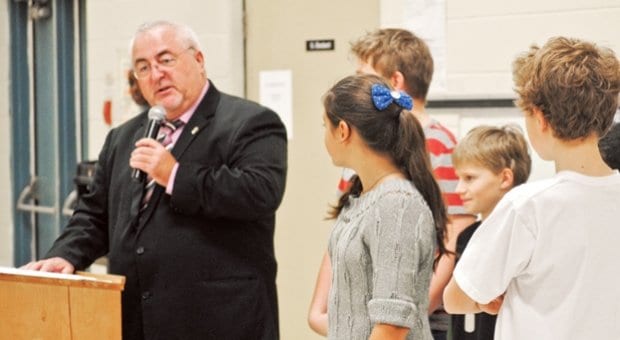Jamie Hubley. Amanda Todd. Rehtaeh Parsons.
Eyes soften and stomachs twist when we hear their names. Their young lives cut short are painful reminders of the worst consequence of oppression. The word bullying is inadequate to describe the suffering they endured, yet at the same time their experiences have prompted community leaders and politicians across the country to do something about this crisis we call bullying.
Hubley, 15, took his life on Oct 14, 2011. His Tumblr blog recounted the Ottawa teen’s struggles with depression, self-injury and the isolation of being the only openly gay kid at his high school. The weight of homophobic bullying, which he experienced relentlessly in person and online, became too heavy to bear.
Two years later, schools, political leaders, youth advocates and community members in Ottawa and beyond are engaged in efforts to prevent and respond to bullying. But is it working?
“I think we’ve really increased the awareness of the issue, for certain,” says Allan Hubley, an Ottawa city councillor and Jamie’s father. “More people have a commitment to do something about it and are making the personal effort to not bully. Most importantly is engaging the bystander, and I think we’ve really got a strong commitment from people who would be a bystander to bullying in the past that now when they see it, they say, ‘No, not in my community.’”
Jeremy Dias, founder and executive director of Jer’s Vision, an anti-bullying organization aimed at ending homophobia, transphobia and discrimination in schools, says it’s important to recognize the complexity of bullying.
“Saying we want to stop bullying is like saying we want to stop all infection,” Dias says. “All infections are not transmitted the same way … There’s different sources of the problem, so there’s no sort of blanket solution.”
When Dias gives workshops in schools, he talks about the racist and homophobic bullying he experienced as a high school student. He encourages students to think about discrimination and intersectionality — how transphobia, sexism, ableism, xenophobia and classism send messages that it’s okay and even expected for students to treat some of their peers differently.
Being aware of oppression means seeing that Amanda Todd’s and Rehtaeh Parsons’s lives and deaths weren’t isolated, unrelated examples of suffering. Effective anti-bullying education isn’t just about telling kids not to say “fag” or “slut” but has to include talking about the history and relationship between homophobia, misogyny and violence, Dias says.
A community, a culture, a country mourns when we lose a young person to suicide, but in our mourning we have to ensure our efforts to address bullying’s root causes are effective, he says.
“The idea that anti-bullying education can disappear after a handful of grants and workshops is delusional,” Dias says. “This work is about constantly challenging ourselves as human beings to create a better community, a better society, a better world. It involves dialogue, it involves compromise, it involves learning.”
Brett Reynolds, principal of the Ottawa-Carleton District School Board’s (OCDSB) Inclusive, Safe and Caring Programs, agrees that anti-bullying education has to be introduced early, reinforced often and developed from evidence-based programs.
“Teachers and all staff in the schools are being told that they need to constantly find different ways to teach kids about positive behaviours, positive relationships,” Reynolds says. “It’s ongoing. It’s not a one-time ‘Hey, we had a guest speaker.’”
At its root, bullying isn’t only about inequality; it’s about conflict, he says. The Fourth R, often used in ninth-grade phys ed classes, refers to “relationships” and promotes better understanding and communication. Studies have linked the program to decreased bullying, he says.
“Through role play and trying to immerse yourself in different perspectives … not only does it help them develop empathy for others, but also they get to practise a better language, better strategies for dealing with conflict when it arises,” he says.
While schools and organizations like Jer’s Vision are working to prevent bullying, bullying hasn’t disappeared from our schools. Sometimes parents are unsatisfied with a school’s response to bullying, Reynolds says.
“We often have students or parents — they want the bully expelled,” he says. “Really we have a duty, an obligation, to serve all of our kids as best we can. Sometimes people just aren’t satisfied with the other things that we put in place.”
Typically, parents of all the students involved are notified. A student who’s been bullying can lose privileges and may face suspension, but counselling is an important resource for both bullied and bullying students, he says. Schools have to be safe spaces for all students, and counselling can uncover problems at home and undiagnosed learning disabilities and can reveal that a bully is also a victim of bullying by other students, Reynolds says.
Two years later, are schools safer? “I believe Ottawa schools are safer for all kids because of the changes that are being made in people’s attitudes,” Hubley says. “There are efforts going on across the country to try to do something about bullying. Now we’re seeing government announcements and serious funding towards the issue as well, so I’m very happy about that.”
In terms of promoting diversity, the OCDSB participates in the Capital Pride parade every year and also hosts an annual Rainbow Youth Forum, one of the largest of its kind in Canada, which this year featured queer Toronto comedian Sabrina Jalees as a guest speaker.
There are gay-straight alliances (GSAs) or diversity clubs in virtually all OCDSB secondary schools, Reynolds says. Ontario’s anti-bullying bill, which was passed in June 2012, also put an end to the GSA embargo in local Catholic schools. Although an Ottawa Catholic School Board spokeswoman couldn’t provide the number of schools that have them, she confirmed that GSAs are allowed in local Catholic schools.
Reynolds, Dias and Hubley agree that the more we pay attention to the issue, the greater the need to check our own privilege, our own behaviour. It isn’t only parents and educators who influence our youth, but all community members. Ultimately, the way we treat each other will encourage or help to combat the presence of bullying in our culture.


 Why you can trust Xtra
Why you can trust Xtra


